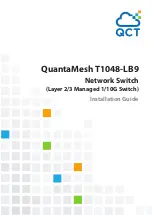
Copying a Configuration File from the Device to an RCP Server
You can copy a configuration file from the device to an RCP server.
One of the first attempts to use the network as a resource in the UNIX community resulted in the design and
implementation of the remote shell protocol, which included the remote shell (rsh) and remote copy (rcp)
functions. Rsh and rcp give users the ability to execute commands remotely and copy files to and from a file
system residing on a remote host or server on the network. The Cisco implementation of rsh and rcp
interoperates with standard implementations.
The rcp
copy
commands rely on the rsh server (or daemon) on the remote system. To copy files using rcp,
you need not create a server for file distribution, as you do with TFTP. You need only to have access to a
server that supports the remote shell (rsh). (Most UNIX systems support rsh.) Because you are copying a file
from one place to another, you must have read permission on the source file and write permission on the
destination file. If the destination file does not exist, rcp creates it for you.
Although the Cisco rcp implementation emulates the functions of the UNIX rcp implementation—copying
files among systems on the network—the Cisco command syntax differs from the UNIX rcp command syntax.
The Cisco rcp support offers a set of
copy
commands that use rcp as the transport mechanism. These rcp
copy
commands are similar in style to the Cisco TFTP
copy
commands, but they offer an alternative that provides
faster performance and reliable delivery of data. These improvements are possible because the rcp transport
mechanism is built on and uses the TCP/IP stack, which is connection-oriented. You can use rcp commands
to copy system images and configuration files from the device to a network server and vice versa.
You also can enable rcp support to allow users on remote systems to copy files to and from the device.
To configure the Cisco IOS software to allow remote users to copy files to and from the device, use the
ip
rcmd rcp-enable
global configuration command.
Restrictions
The RCP protocol requires a client to send a remote username on each RCP request to a server. When you
copy a configuration file from the device to a server using RCP, the Cisco IOS software sends the first valid
username it encounters in the following sequence:
1.
The username specified in the
copy
EXEC command, if a username is specified.
2.
The username set by the
ip rcmd remote-username
global configuration command, if the command
is configured.
3.
The remote username associated with the current tty (terminal) process. For example, if the user is connected
to the device through Telnet and was authenticated through the
username
command, the device software
sends the Telnet username as the remote username.
4.
The device host name.
For the RCP copy request to execute successfully, an account must be defined on the network server for the
remote username. If the server has a directory structure, the configuration file or image is written to or copied
from the directory associated with the remote username on the server. For example, if the system image resides
in the home directory of a user on the server, you can specify that user name as the remote username.
Use the
ip rcmd remote-username
command to specify a username for all copies. (Rcmd is a UNIX routine
used at the super-user level to execute commands on a remote machine using an authentication scheme based
on reserved port numbers. Rcmd stands for “remote command”). Include the username in the
copy
command
if you want to specify a username for that copy operation only.
System Management Configuration Guide, Cisco IOS XE Fuji 16.8.x (Catalyst 9500 Switches)
182
Managing Configuration Files
Copying a Configuration File from the Device to an RCP Server
















































